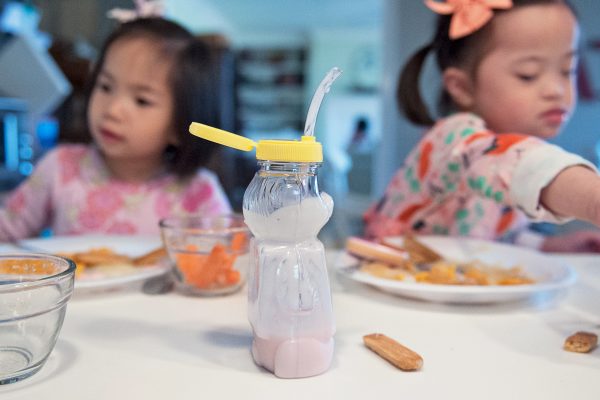Feeding your child is one of the most basic ways you can bond, and yet can become the one most challenging aspects of parenting for many adoptive families.
In this three-part series, Speech Therapist Melissa Pouncey will provide practical places to start working towards peaceful and healthy eating habits, along with more therapeutic information regarding feeding disorders.

Part 1: Begin with Basics
Part 2: Oral Motor Differences and Feeding
Part 3: Feeding Therapy and Finding the Right Fit
From the beginning of our lives, food means love. Our first experiences with our families involve filling our bellies – it’s how we bond with one another and how our parents learn about our needs. One of the first words little ones learn to say is “eat”. Food is how we fellowship with one another, how we socialize, and how we make some of our deepest memories.

When you’re the parent of a child who has experienced hard places, whether in foster care or adoption, eating and food might not have the positive feelings and meanings that is has for others. Eating may be tied to anxiety, deep hunger, or routines that lacked a nurturing touch. For these reasons, creating positive eating habits may be difficult, but crucial to your child making progress, enjoying social eating experiences, and growing healthfully.
In this first post, we’ll talk about some general, practical strategies for improving mealtime for all children.

1. Make meals and snacks into predictable, social routines.
• Give meals and snacks a clear beginning and ending that are happy and fun that your child can learn to play an active role in. Your child can, and should participate in choosing and arranging their snacks and meals, getting out plates, bowls, cups, ect. Sing a song together, and help them make choices as they are able. Arrange the table together, and be sure to sit together to eat.
• At the end of the meal, no matter how it went, clean up together. Have your child clean off the table and clear things away, every time. This gives your child the knowledge that you can always end the routine well.
• Always give your child a way to ask for more or talk about being finished, even if they don’t have the words. Use sign language, picture symbols, or words to help them request needs be met. Communication is so important to easing anxieties!

2. Use positive language when talking about food and your child’s behavior.
• No matter what you may think – your child hears and understands you. Even if not in exact words, but in your own anxieties and worries, your child can read your body language. Calm yourself before you sit down to eat and react as little as possible to any negative behaviors that may occur at the table.
• Replace “no” and “don’t” with “can do” statements. Rather than saying “Don’t throw”, use phrases like “You can hand it to me” or “You can move that off your plate”. Other examples could be: You can wipe your hands. You can get more. You can try a bite. You can do it too. This kind positive language is so important to empowering children and giving them knowledge about acceptable behavior.
• Sometimes giving food a name can create negative associations or build on already existing negative associations. Try using words to describe when a food looks, smells, feels like, or what color it is. Giving neutral descriptors like a “crunchy orange stick” (carrot) and “squishy white circle” (banana cut up) can give a child good information about foods without it being about labels.

3. Allow your child some control over choosing the contents of what’s on their plate.
• Eating meals family style (with large containers of food that everyone serves themselves from) can give your child the opportunity to control portions. Make no demands for the contents of their plate early on (work up to it!), and ensure there’s always something (if not several somethings) they enjoy at the table – even if it doesn’t “go” with the meal.
• Eating family style does not have to be fancy! Allowing older children to participate in food prep means you might be serving sandwiches on a napkin for everyone or taking a tub of mashed potatoes out of the microwave straight to the table.
• If there are foods that your child doesn’t enjoy in particular, move slowly in introducing them. For some children, just being in the same space as a food may be a struggle. You can give your child an “out” by creating a safe space for it. Some methods of feeding therapy call this a “learning plate”, or an empty plate (or could be a bowl, napkin) free for food to go when it isn’t wanted (rather than the floor).

4. Make food playful and fun!
• Many children skip crucial steps in sensory exploration and food play, or this skill set may be disordered. Spending time touching, experiencing, and playing in and with food is very important, no matter the age of the child. Make the chips dance up your arm, build with crackers, break rice cakes and make snowflakes, roll eggs into balls. The more fun you can have with food, the more engaged your child will be!
• Food play can happen anywhere – especially if just sitting at the table causes anxiety. You could play and enjoy food in the kitchen, where it’s made!
• Many children may need to see what happens with a food outside of their mouth before it goes in. This is why small children touch and play with food, and why many children examine food before they try it. Give them the opportunity together! Talk about what sound it makes when you bite into it, what it feels like, how it breaks, and what it tastes like as you play together.
• Feeding one another builds trust, both in you and in the food. Never hesitate to let your child feed you, or feed your child, no matter their age.

Remember, good feeding habits can be hard to build, so if things aren’t going well – don’t give up.
Always seek out the advice and support of local feeding professionals if your child isn’t making progress with basic strategies and time passing. Speech therapists and occupational therapists are both able to provide professional support, if needed. Those referrals will often come through your pediatrician, so be honest about your feeding concerns with your doctor or medical team.
However, many children, both with and without a special needs diagnosis, become problem feeders as a result of poor oral motor skills. In part two we’ll talk about where those might originate, how to spot them, and some general intervention strategies.
– guest series by Melissa Pouncey MS CCC-SLP; with the invaluable expertise of OTs Megan Carpenter OTR/L SCFES and Nicole Rollier OTR/L

Melissa Pouncey graduated from the University of Alabama with her MS in Communicative Disorders in 2010. She has been joyfully serving children and families with United Ability since the day after graduation in the natural environment setting, inclusive preschool, and outpatient programs. She contributed knowledge to Lifeline Children’s Services in training for social workers, and training families in Crossings. In 2016 she travelled to China with Lifeline to train caregivers in Lifeline’s foster center and several orphanages. Her specialties include international adoption, Autism, AAC for children with multiple needs, oral placement therapy for speech and feeding, and child advocacy. Melissa is state board certified as well as American Speech and Hearing Association (ASHA) certified.

























Leave a Reply